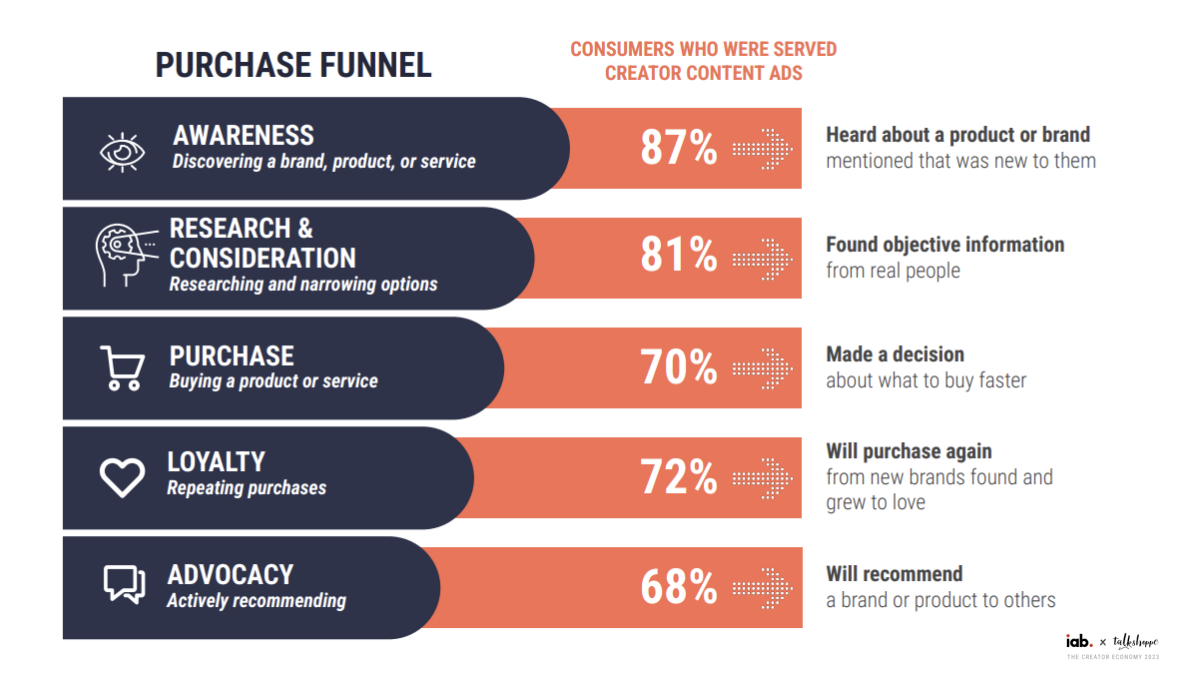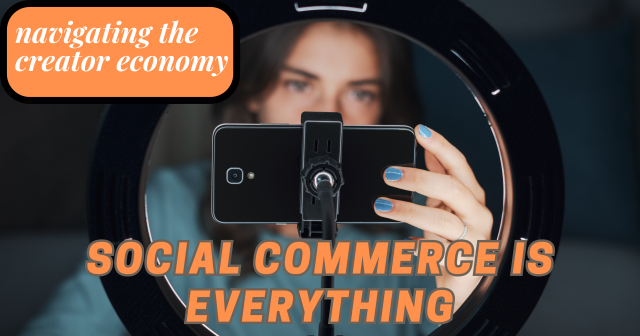
TL;DR
- New research shows that advertising alongside creator content speeds up the consumer purchase journey, collapsing traditional stages like awareness, interest, and consideration.
- According to a report from digital advertising trade group IAB, 92% of advertisers view creator-led content as a high-quality channel, with many planning to increase investment in this area.
- Jack Koch, SVP of Research & Insights at IAB, emphasizes the unique appeal and integration of ads in creator content compared to studio-produced content, affecting consumer behavior and advertising effectiveness.
- Koch outlines strategies for blending creator content into traditional advertising, focusing on leveraging creator-driven platforms, clear tracking mechanisms, and brand safety controls.
- A balanced mix of studio and creator content is essential for engaging diverse viewers, he says, with emphasis on data analysis, audience understanding, and quality content alignment.
READ MORE: IAB Releases First-of-Its-Kind Research Report on the Creator Economy Advertising Opportunity (IAB)
The ever-evolving advertising landscape finds a fresh ally in the creator economy, offering brands a direct line to more genuine, engaging connections with their audience. Digital advertising trade group IAB has released its first-ever research report on advertising opportunities within the creator economy. The report, titled “The Creator Economy Opportunity: Where Authenticity Meets Impact,” was conducted in partnership with market research agency Talk Shoppe, and offers a deep examination of the evolving consumer purchase journey, how buyers can leverage the creator economy in their media budgets, and where creator content fits in the media mix alongside studio-produced content.
“The creator economy, valued at $250 billion this year by Goldman Sachs, is expected to nearly double to $480 billion by 2027. Savvy marketers know that they need to reach their customers in content that resonates with them,” IAB CEO David Cohen said in a statement. “There is no doubt creator content is now a vital part of the mix.”
After tracking more than 1,000 consumer purchase journeys, the report found that advertising alongside creator content can accelerate the purchase funnel — collapsing the awareness, interest, and consideration stages. IAB also reported that creator content sparks more action when compared to studio-produced content: after watching, consumers were significantly more likely to search for additional content about the topic and interact with the content by liking, commenting, or subscribing.

Advertisers themselves are feeling bullish about creator-led content, which 92% of respondents said they consider to be a high quality channel. Around 44% of advertisers plan to increase their investment in creator content in 2024, the report found, with an average increase of 25%. Perhaps most important, advertisers don’t have to reinvent the wheel to measure the success of their campaigns. Nearly 90% of advertisers use the same KPI metrics across both creator content and studio content, and 86% of advertisers have confidence in the ability to measure the effectiveness of creator content campaigns.
Influencers Gotta Influence
Jack Koch, SVP of Research & Insights at IAB, elaborated to NAB Amplify on how creator content influences each stage of the consumer purchase journey.
“Creator content marketing significantly influences the consumer’s purchase journey, from discovering new brands and products to speeding up buying decisions and driving post-purchase loyalty and advocacy,” Koch said. “Creator content is exceptionally powerful in the research/consideration and loyalty/advocacy stages and works in tandem with studio content to maximize influence on the consumer’s path to purchase.”
The perceived authenticity of creator-led content, he added, “allows consumers to visualize products in their daily lives, enabling multiple stages to happen simultaneously. This compresses the purchase funnel and fosters a more confident and rapid buyer decision-making process.”
Creator Content Is Premium Content
The evolving world of digital advertising isn’t just about where ads are placed; it’s equally about how they are perceived. Koch offers insights into how consumer perceptions vary markedly between creator and studio-produced content.
“Consumer perceptions of advertising in creator versus studio content showcase distinct viewpoints,” he explains. This difference is fundamental to understanding the shift in advertising dynamics. Creator content, as per Koch’s analysis, is perceived as “a more engaging and relevant space for ads, offering unexpected inspiration and precise audience targeting.” This is in contrast to studio content, which, while celebrated for its high production value and broad reach, occupies a different niche in the advertising ecosystem.

The distinction becomes more pronounced when considering how ads are integrated into the content. “Consumers perceive ads within creator content as more seamlessly integrated into their viewing experience,” Koch notes.
In contrast, studio content, with its traditional approach, brings a different kind of advantage. “Ads in studio content are deemed slightly more memorable due to familiarity with advertising in that space,” he says. This familiarity stems from years of exposure to traditional advertising formats, making studio content ads more recognizable and, in some cases, more memorable to consumers.
In essence, the authenticity of creator content and the established familiarity of studio content offer two sides of the same coin. Advertisers, by understanding and respecting these differences, can develop more nuanced and effective advertising campaigns that speak directly to the evolving preferences of their audience.
Challenges and Strategies for Embracing Creator-Driven Content
Incorporating creator content into traditional advertising strategies is not without its challenges. Koch sheds light on the complexities and the potential strategies to navigate these waters effectively.
The primary hurdles in merging creator content with traditional advertising stem from three areas: “uncertainty, unpredictability, and initial navigation hurdles,” Koch says.
“Advertisers who might choose not to spend with creators struggle with the uncertainty of ad placement within creator content, hindering alignment with brand values and control over ad environments,” he points out.
This uncertainty can lead to concerns about whether the content aligns with the brand’s values and whether it can be controlled effectively within the advertising environment. “Further, the less predictable performance of creator content complicates ROI tracking and campaign evaluation. Navigating the expansive creator space overwhelms advertisers due to its diverse options.”
To address these challenges, Koch recommends a strategic approach centered on leveraging creator-driven platforms. These platforms offer more control over ad placement and provide advanced analytics tools for real-time performance tracking. Such tools can mitigate the unpredictability factor by offering clearer insights into campaign effectiveness.
Koch also emphasizes the importance of clear tracking mechanisms, like unique discount codes, especially when partnering directly with creators. These mechanisms enable advertisers to assess the performance of their campaigns more accurately and make data-driven decisions.
Furthermore, embracing brand safety controls is crucial. Koch suggests utilizing technological advancements such as AI content monitoring and participating in industry initiatives aimed at creating safer digital environments. By integrating these creator-driven platforms and strategies, he says, advertisers can harmonize traditional and digital media to effectively achieve their campaign objectives.
The Winds of Change
Valued at $250 billion and projected to reach $480 billion by 2027, the Creator Economy is driving a major shift in digital video viewership.
“While traditional studio content remains vital, creator content has become indispensable in advertising strategies, as 39% of consumers are watching more creator content than they were a year ago, compared to 22% watching more studio content across devices and services,” Koch says. “In fact, according to our study, 89% of advertisers feel positive about creator content advertising, and 92% consider it a high-quality channel.”

Embracing creator-driven content isn’t just a trend; it’s an essential strategy in a landscape where authenticity and multipoint audience engagement reign supreme. “By building trust with partners and creators, aligning budgets with areas of highest consumer impact, and focusing on aligning with quality content, marketers are finding long-term success integrating creator-driven advertising into their holistic media strategies.”
Maintaining Brand Integrity
To effectively integrate creator content while upholding brand integrity and meeting marketing goals, brands should carefully select creators whose content aligns with their values and resonates with the target audience, Koch says. Further, “encouraging an authentic integration of the brand within creator content is vital to maintaining authenticity and trust.”
Adaptability and flexibility are key, he says, allowing brands to refine strategies based on performance feedback. “Diverse partnerships with a range of creators help widen brand appeal across different consumer segments,” he advises.
“Robust measurement tools and unique tracking methods ensure accurate assessment of creator content impact, and leveraging creator-driven platforms for better ad control and embracing brand safety tools are crucial for maintaining brand integrity.”
Finally, Koch advises, brands need to build meaningful relationships with creators. “Fostering long-term relationships with creators and using insights from their content for continuous optimization enables brands to create a cohesive presence across traditional and digital media.”
Winning Strategies for the Ideal Media Mix
“A balanced media mix is crucial,” Koch exhorts. “Studio content can spark conversations and immerse viewers, while creator content captivates with its personally relevant nature that inspires and engages. Both content types meet the diverse needs of viewers, establishing that ‘quality’ content is subjective.”
Advertisers, he says, “should analyze data from both types of content to understand their audience demographics, engagement levels, and performance metrics. Testing and iterating the mix while aligning it with campaign objectives will yield the ideal balance for maximum impact.”
The formula, he says, is simple: “By building trust with partners and creators, aligning budgets with areas of highest consumer impact, and focusing on aligning with quality content, marketers are finding long-term success integrating creator-driven advertising into their holistic media strategies.”



Discussion
Responses (1)